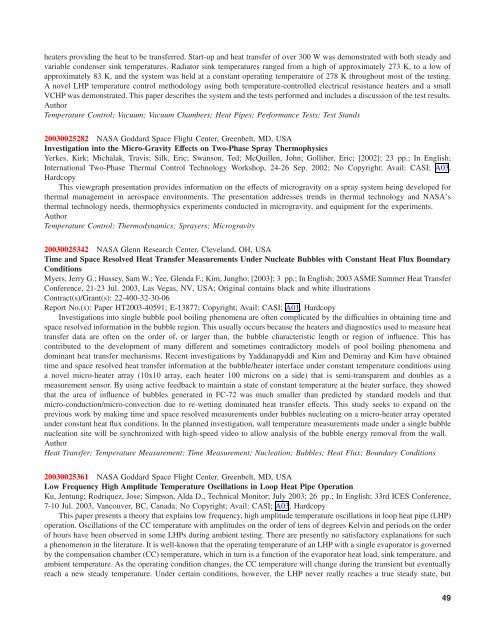You also want an ePaper? Increase the reach of your titles
YUMPU automatically turns print PDFs into web optimized ePapers that Google loves.
heaters providing the heat to be transferred. Start-up and heat transfer of over 300 W was demonstrated with both steady and<br />
variable condenser sink temperatures. Radiator sink temperatures ranged from a high of approximately 273 K, to a low of<br />
approximately 83 K, and the system was held at a constant operating temperature of 278 K throughout most of the testing.<br />
A novel LHP temperature control methodology using both temperature-controlled electrical resistance heaters and a small<br />
VCHP was demonstrated. This paper describes the system and the tests performed and includes a discussion of the test results.<br />
Author<br />
Temperature Control; Vacuum; Vacuum Chambers; Heat Pipes; Performance Tests; Test Stands<br />
20030025282 NASA Goddard Space Flight Center, Greenbelt, MD, USA<br />
Investigation into the Micro-Gravity Effects on Two-Phase Spray Thermophysics<br />
Yerkes, Kirk; Michalak, Travis; Silk, Eric; Swanson, Ted; McQuillen, John; Golliher, Eric; [2002]; 23 pp.; In English;<br />
International Two-Phase Thermal Control Technology Workshop, 24-26 Sep. 2002; No Copyright; Avail: CASI; A03,<br />
Hardcopy<br />
This viewgraph presentation provides information on the effects of microgravity on a spray system being developed for<br />
thermal management in aerospace environments. The presentation addresses trends in thermal technology and NASA’s<br />
thermal technology needs, thermophysics experiments conducted in microgravity, and equipment for the experiments.<br />
Author<br />
Temperature Control; Thermodynamics; Sprayers; Microgravity<br />
20030025342 NASA Glenn Research Center, Cleveland, OH, USA<br />
Time and Space Resolved Heat Transfer Measurements Under Nucleate Bubbles with Constant Heat Flux Boundary<br />
Conditions<br />
Myers, Jerry G.; Hussey, Sam W.; Yee, Glenda F.; Kim, Jungho; [2003]; 3 pp.; In English; 2003 ASME Summer Heat Transfer<br />
Conference, 21-23 Jul. 2003, Las Vegas, NV, USA; Original contains black and white illustrations<br />
Contract(s)/Grant(s): 22-400-32-30-06<br />
Report No.(s): Paper HT2003-40591; E-13877; Copyright; Avail: CASI; A01, Hardcopy<br />
Investigations into single bubble pool boiling phenomena are often complicated by the difficulties in obtaining time and<br />
space resolved information in the bubble region. This usually occurs because the heaters and diagnostics used to measure heat<br />
transfer data are often on the order of, or larger than, the bubble characteristic length or region of influence. This has<br />
contributed to the development of many different and sometimes contradictory models of pool boiling phenomena and<br />
dominant heat transfer mechanisms. Recent investigations by Yaddanapyddi and Kim and Demiray and Kim have obtained<br />
time and space resolved heat transfer information at the bubble/heater interface under constant temperature conditions using<br />
a novel micro-heater array (10x10 array, each heater 100 microns on a side) that is semi-transparent and doubles as a<br />
measurement sensor. By using active feedback to maintain a state of constant temperature at the heater surface, they showed<br />
that the area of influence of bubbles generated in FC-72 was much smaller than predicted by standard models and that<br />
micro-conduction/micro-convection due to re-wetting dominated heat transfer effects. This study seeks to expand on the<br />
previous work by making time and space resolved measurements under bubbles nucleating on a micro-heater array operated<br />
under constant heat flux conditions. In the planned investigation, wall temperature measurements made under a single bubble<br />
nucleation site will be synchronized with high-speed video to allow analysis of the bubble energy removal from the wall.<br />
Author<br />
Heat Transfer; Temperature Measurement; Time Measurement; Nucleation; Bubbles; Heat Flux; Boundary Conditions<br />
20030025361 NASA Goddard Space Flight Center, Greenbelt, MD, USA<br />
Low Frequency High Amplitude Temperature Oscillations in Loop Heat Pipe Operation<br />
Ku, Jentung; Rodriquez, Jose; Simpson, Alda D., Technical Monitor; July 2003; 26 pp.; In English; 33rd ICES Conference,<br />
7-10 Jul. 2003, Vancouver, BC, Canada; No Copyright; Avail: CASI; A03, Hardcopy<br />
This paper presents a theory that explains low frequency, high amplitude temperature oscillations in loop heat pipe (LHP)<br />
operation. Oscillations of the CC temperature with amplitudes on the order of tens of degrees Kelvin and periods on the order<br />
of hours have been observed in some LHPs during ambient testing. There are presently no satisfactory explanations for such<br />
a phenomenon in the literature. It is well-known that the operating temperature of an LHP with a single evaporator is governed<br />
by the compensation chamber (CC) temperature, which in turn is a function of the evaporator heat load, sink temperature, and<br />
ambient temperature. As the operating condition changes, the CC temperature will change during the transient but eventually<br />
reach a new steady temperature. Under certain conditions, however, the LHP never really reaches a true steady state, but<br />
49
















